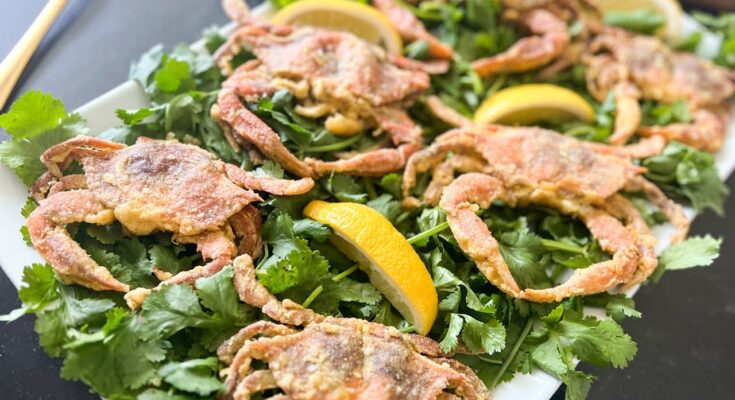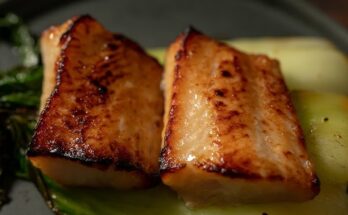Soft Shell Crab Recipe: Soft shell crab is a culinary delicacy that turns a seasonal seafood catch into a crispy, flavorful, and unforgettable dish. What sets it apart? These crabs are harvested just after they molt their old exoskeleton, which means the entire crustacean – shell and all – is soft, edible, and bursting with sweet, briny flavor. There’s no need for cracking shells or messy cleanup. It’s all-in-one bite perfection.
This recipe will walk you through everything you need to know – from selecting the freshest crabs to achieving the perfect golden crunch. Whether you’re a seafood lover looking to explore something new or a home cook wanting to wow guests with a five-star plate, this soft shell crab recipe has got your back. Plus, we’ll share tips, serving ideas, and even a few mouthwatering variations. Let’s dive in!
Ingredients You’ll Need
When it comes to making soft shell crab, the ingredients are simple, but each one plays a crucial role in building flavor, texture, and that irresistible golden crust.
Freshness is Key – Choosing the Right Crabs
First and foremost, the star of this recipe is, of course, the soft shell crab itself. Here’s what to look for:
- Buy live if possible. Freshness is everything with seafood. Soft shell crabs should be bought live or cleaned on the same day from a reputable fish market.
- Seasonal availability: Typically, soft shell crabs are available from late spring to early fall, especially around May through September in the U.S.
- Size preference: “Hotel size” is commonly used in recipes (about 4-4.5 inches), but if you prefer larger or smaller, adjust cooking time accordingly.
Core Ingredients
Here’s your essential shopping list to make classic fried soft shell crab:
- 4 soft shell crabs (cleaned)
- 1 cup all-purpose flour
- 1/2 cup cornmeal (optional, for extra crunch)
- Salt and freshly ground black pepper
- 1/2 teaspoon garlic powder
- 1/2 teaspoon paprika
- 1/4 teaspoon cayenne pepper (optional, for heat)
- 2 eggs
- 1/4 cup milk or buttermilk
- Vegetable oil or peanut oil (for frying)
Optional Flavor Enhancers and Garnishes
Want to elevate your crabs from great to gourmet? Add these extras to your ingredient list:
- Fresh lemon wedges – For that citrus zing at the end.
- Fresh herbs like parsley or dill – Chopped and sprinkled after frying.
- Remoulade sauce or aioli – For dipping or drizzling.
- Hot sauce – If you love some heat.
- Old Bay seasoning – A classic choice for seafood lovers.
Tools and Kitchen Essentials
Having the right equipment makes everything smoother:
- Cast-iron skillet or deep frying pan – Retains heat better and ensures even frying.
- Tongs – For turning and lifting crabs safely.
- Paper towels and a wire rack – For draining excess oil.
- Mixing bowls – For dredging station (flour and egg mix).
- Meat thermometer (optional) – Helps keep oil at the perfect temp (350–375°F).
Preparation Before Cooking
Before the crabs even hit the oil, there’s some crucial prep work. Cleaning, seasoning, and marinating might seem like small steps, but they make a massive difference in the final dish’s flavor and texture.
How to Clean Soft Shell Crabs Properly
If you bought pre-cleaned crabs from your fishmonger, you’re good to go. But if you bought them live or whole, here’s how to clean them:
- Cut off the face: Hold the crab belly side down. Using sharp kitchen shears, snip about ½ inch off the front of the crab to remove the eyes and mouth.
- Lift and remove the gills: Flip the top shell (called the carapace) and gently lift each side. Remove the feathery gills underneath.
- Remove the apron: On the underside of the crab, you’ll see a small tab (the apron). Lift it and cut it off.
Once cleaned, rinse lightly under cold water and pat dry thoroughly. Never soak crabs or leave them sitting in water—they’ll become soggy and lose flavor.
Marinating for Flavor Boost
While not always necessary, marinating soft shell crabs can infuse them with added flavor and tenderness. Here’s a quick marinade idea:
- Marinade base: Buttermilk, a dash of hot sauce, salt, and garlic powder.
- Time: Let the crabs marinate for about 20–30 minutes in the fridge.
This step helps tenderize the crab and gives the crust a richer, more complex flavor profile once fried.
Tips for Optimal Texture and Taste
- Pat dry before coating. Wet crabs = soggy crust.
- Season every layer. That means the flour, the egg wash, and the crabs themselves.
- Rest before frying. Let the crabs sit for 5–10 minutes after dredging. It helps the coating stick better and gives you a crispier result.
Step-by-Step Cooking Instructions
Now that your crabs are cleaned and your ingredients are ready, it’s time to cook! This step-by-step guide ensures golden, crispy crabs every single time.
Step 1: Prepping Your Station
Before you begin, set up your frying station. You’ll need cleaned soft-shell crabs, flour or batter ingredients, oil for frying, and paper towels or a wire rack for draining. Heat about 1½ inches of oil (vegetable or peanut oil works best) in a deep skillet or pan over medium-high heat until it reaches 350°F (175°C). While the oil heats, pat your crabs completely dry with paper towels — moisture is the enemy of crispiness.
Step 2: Coating the Crabs – Flour or Batter?
Decide how you want to coat your crabs:
- Flour Dredge: Combine 1 cup of flour, 1 teaspoon salt, ½ teaspoon pepper, and optional spices like paprika or cayenne. Dredge each crab in the seasoned flour until fully coated, shaking off the excess.
- Wet Batter: For a crispier shell, whisk together ¾ cup flour, ¼ cup cornstarch, 1 teaspoon baking powder, salt, pepper, and cold sparkling water or beer until smooth. Dip each crab into the batter, letting the excess drip off.
Either way, your coating should cling lightly — not clump — to achieve that perfect golden crunch.
Step 3: Frying the Crabs to Crispy Perfection
Once your oil is hot, gently place the crabs in the skillet, shell-side down first. Fry 2–3 crabs at a time (don’t overcrowd the pan) for about 2–3 minutes per side, or until they turn deep golden brown and crisp. Flip carefully with tongs to avoid splattering. You’ll know they’re ready when the shells are crunchy and the aroma is irresistible.
Step 4: Draining and Resting the Crabs
Using tongs, transfer the fried crabs to a wire rack or paper towel-lined plate to drain excess oil. Let them rest for 2–3 minutes before serving — this keeps them crisp and allows the juices to settle. If cooking in batches, keep them warm in a 200°F (95°C) oven while you finish frying the rest.
Step 5: Plating and Serving Suggestions
Serve your crispy soft-shell crabs immediately — that’s when they shine. You can plate them with a side of coleslaw, lemon wedges, and tartar sauce, or place them on a buttered brioche bun with lettuce, tomato, and remoulade for a killer crab sandwich.
Golden, crunchy, and packed with ocean flavor — these fried soft-shell crabs are pure coastal indulgence. Each bite crackles with texture and melts with rich, buttery sweetness.
Delicious Variations You Can Try
Once you’ve nailed the basic recipe, the sky’s the limit. Here are a few creative spins to try out:
Spicy Soft Shell Crab
Love heat? Spice things up with a bold seasoning blend.
- Add cayenne, smoked paprika, and chili flakes to your flour mix.
- Serve with sriracha mayo or a spicy mango salsa for a fiery kick.
- Top with pickled jalapeños for that tangy bite.
This version is a crowd-pleaser for spice lovers who want more than just the traditional flavor.
Soft Shell Crab Po’ Boy Sandwich
A classic Louisiana favorite turned gourmet!
- Toast a French roll or hoagie bun with butter.
- Layer with shredded lettuce, sliced tomato, and pickles.
- Add the crispy crab and smother it with Cajun remoulade or spicy mayo.
- Serve with Cajun fries or coleslaw on the side.
This sandwich is hearty, indulgent, and bursting with Southern soul.
Asian-Inspired Soy Garlic Version
Add an Eastern twist to your soft shell crab with this umami-rich idea:
- After frying, toss the crabs in a glaze made from soy sauce, garlic, ginger, honey, and a splash of rice vinegar.
- Garnish with scallions and sesame seeds.
- Serve over steamed rice or noodles with stir-fried veggies.
This version gives your dish a sweet, salty, and slightly tangy edge that’s impossible to resist.
What to Serve with Soft Shell Crab
Pairing is key to a well-rounded seafood experience. Here are some thoughtful and delicious ideas to serve alongside soft shell crab:
Side Dish Ideas
- Coleslaw: Tangy and crunchy, it balances the richness of fried crab.
- Grilled corn on the cob: A summertime favorite that complements seafood beautifully.
- Garlic butter pasta: Light and savory, great with a lemony crab finish.
- Avocado salad: Creamy and refreshing, it cuts through the oil and adds contrast.
- Crispy roasted potatoes or fries: A classic choice that pairs well with sandwiches or platters.
These side dishes don’t just fill the plate—they enhance the crab’s flavor profile and complete the meal.
Wine and Drink Pairings
Pair your dish with the perfect beverage:
- White wine: Choose a Sauvignon Blanc or Chardonnay—both have bright acidity that cuts through fried food.
- Beer: A light lager or pilsner complements the crab without overwhelming it.
- Cocktails: A gin and tonic or lemon margarita adds freshness and contrast.
- Non-alcoholic: Iced tea with lemon or a sparkling citrus soda works well too.
Choose drinks that bring balance and keep your palate refreshed.
Storing and Reheating Tips
Let’s say you made a few too many soft shell crabs (hard to imagine, but it happens!). Don’t worry—there are great ways to store and reheat them while preserving their flavor and crispiness.
How Long Can You Store Them?
Soft shell crab is best enjoyed fresh, especially when fried. But if you need to store leftovers:
- Refrigerator: Store cooked crabs in an airtight container lined with paper towels to absorb moisture. They will last up to 2 days.
- Freezer: Though not ideal for already-fried crab, you can freeze uncooked, cleaned soft shell crabs for up to 3 months. Wrap them individually in plastic wrap and then place them in a freezer-safe bag.
Label the date on your freezer bags to ensure you’re using the crabs while they’re still at their best.
Best Way to Reheat Without Losing Crispiness
Reheating fried foods can be tricky, but here’s how to do it right:
- Preheat your oven to 375°F (190°C).
- Place crabs on a wire rack set on a baking sheet. This allows air to circulate all around, keeping the crust crisp.
- Heat for 8–10 minutes, or until warmed through. Don’t overcook, or they’ll dry out.
- Avoid the microwave! It will turn your beautifully crisp crab into a soggy mess.
For best results, reheat only once. After that, the texture and flavor start to decline.
Common Mistakes to Avoid
Even seasoned cooks can mess up soft shell crab if they’re not careful. Here are the most common pitfalls—and how to steer clear of them.
Overcooking
Soft shell crab doesn’t need long in the oil—just 2–3 minutes per side. Overcooking will make the crab rubbery and dry. Always monitor your oil temperature and stick to the recommended fry time.
Improper Cleaning
If you don’t clean the crab properly, those inedible parts will ruin the eating experience. Always remove:
- The eyes and mouthparts
- The gills (also known as “dead man’s fingers”)
- The abdominal apron
If cleaning seems daunting, ask your fishmonger to do it or follow a video tutorial the first time.
Using the Wrong Oil or Temperature
Your choice of oil and how hot it gets is crucial:
- Use oils with a high smoke point like peanut, vegetable, or canola oil.
- Keep oil temperature between 350–375°F (175–190°C).
- Too cool? The crab will soak up oil and be greasy. Too hot? It’ll burn before cooking through.
Use a thermometer if you can. It takes out all the guesswork.
Nutritional Value of Soft Shell Crab
Yes, soft shell crab is indulgent—but it also packs a nutritious punch when enjoyed in moderation. Here’s what you should know:
Macronutrients Breakdown
A single medium soft shell crab (approx. 65g, fried) typically contains:
| Nutrient | Amount |
|---|---|
| Calories | 190–220 |
| Protein | 13–15g |
| Total Fat | 10–14g |
| Saturated Fat | 2–3g |
| Carbohydrates | 8–10g |
| Fiber | 0g |
| Sodium | 300–400mg |
Note: Values vary based on oil, coating, and serving method.
Health Benefits and Considerations
- Rich in protein: Great for muscle maintenance and energy.
- Good source of omega-3 fatty acids: Heart-healthy fats found in most seafood.
- High in essential minerals: Like zinc, selenium, and copper.
- Moderate in calories: A balanced choice when served with lighter sides.
Watch your sodium and fat intake if you’re deep-frying or using heavily seasoned coatings. You can always bake or air-fry for a lighter version.
FAQs about Soft Shell Crab Recipe
Can I air-fry soft shell crab?
Yes! Lightly coat the crab in oil and place it in a preheated air fryer at 375°F. Cook for about 8–10 minutes, flipping halfway. It won’t be as crispy as deep-frying, but it’s a healthier alternative with great flavor.
How do I know when it’s cooked through?
The crab’s shell will turn a deep orange color, and the coating will become golden and crisp. If you’re unsure, insert a fork—there should be no rubbery resistance, and juices should run clear.
What’s the best time of year to buy them?
Soft shell crab season typically runs from late spring through early fall, with peak availability in May to September, depending on your location. Fresh is always best, so shop local if possible.
Are soft shell crabs safe to eat whole?
Yes! Once cleaned, the entire crab—including the shell—is edible. That’s what makes it unique and why it gets that crispy bite when fried or grilled.
Can I freeze soft shell crab before cooking?
Absolutely. Clean the crabs first, then wrap them individually in plastic wrap and place in a freezer bag. Freeze for up to 3 months. Thaw in the fridge before cooking.
Final Thoughts
Soft shell crab is one of those magical dishes that manages to be simple, satisfying, and gourmet all at once. Whether you’re pan-frying them to crispy perfection or stacking them on a sandwich bun with spicy sauce, there’s no wrong way to enjoy this delicacy.
With the right preparation and attention to detail—from choosing fresh crabs to cooking at the ideal temperature—you’ll be able to whip up restaurant-quality soft shell crab at home. It’s a true celebration of seasonal seafood and a standout dish for any special meal.
Try different variations, experiment with bold flavors, and most importantly—don’t forget to enjoy the process (and the delicious results)!



